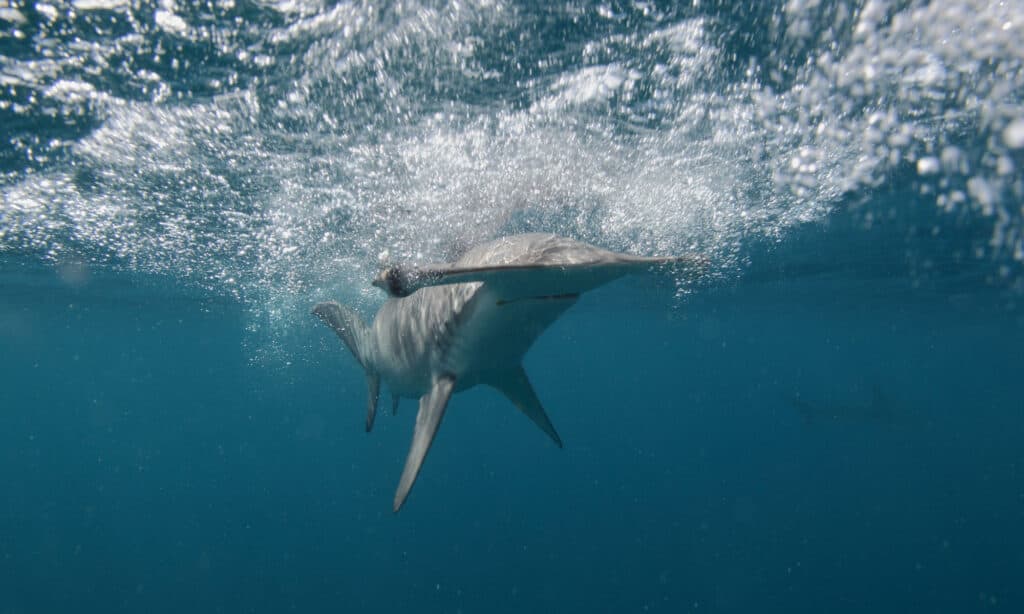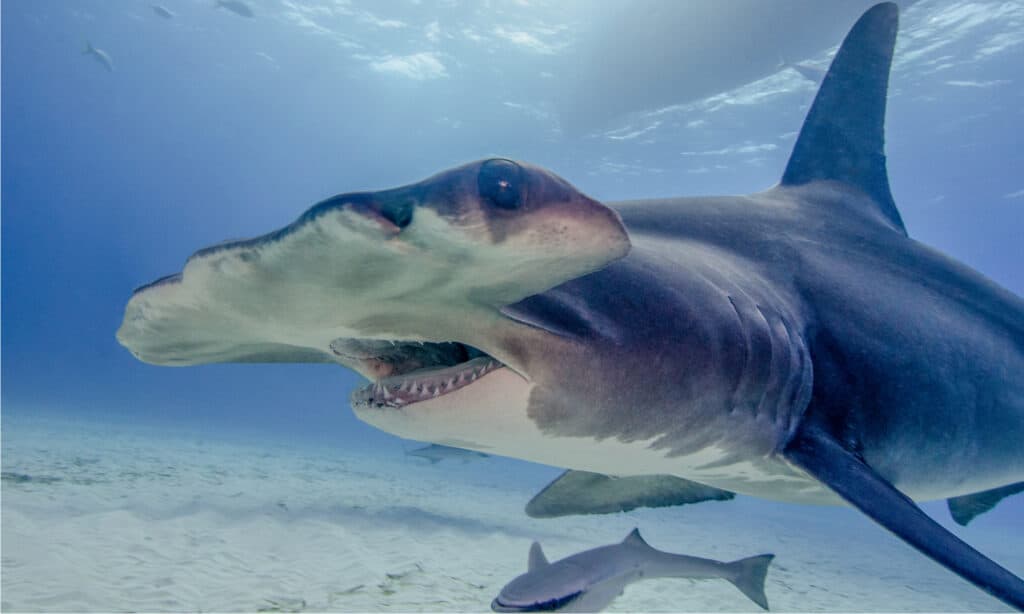The hammerhead shark is one of the most fascinating creatures in the ocean. They are fond of warm waters and are usually found swimming in coastal waters as a school. Their reputation as aggressive food hunters, however, does not extend to human beings as they have not been found hunting or attacking human beings for food.
In this article, we have gathered in detail all you need to know about where hammerhead sharks live and how they choose their homes.
Where Do Hammerhead Sharks Live?

Generally, hammerheads live in the Mesopelagic zone.
©HakBak/Shutterstock.com
Hammerheads live in shallow waters, along the continental shelves and deep waters (up to 900 feet!). Like most predators, they are often in areas where their prey commonly reside. Hammerheads love to hunt stingrays, and these flat-bodied fish hide under the sand. Combined with their preference for warm temperate waters, the shallow areas are a perfect feeding ground for hammerheads. In general, hammerheads live in the Mesopelagic zone.
A large number of these sharks can be found around the Wolf and Darwin Islands of Galapagos, as well as Cocos Island of Costa Rica, Mozambique, Maldives, Japan, and Malaysia. There have been many sightings of groups of hammerheads swimming together in these areas.
Where Do the Different Hammerhead Species Live?

The smooth hammerhead shark is popular off the coasts of Hawaii and California.
©Alessandro De Maddalena/Shutterstock.com
There are about 9 species of the hammerhead shark all of which live in shallow waters. More specifically, Great Hammerheads, which are the largest of the 9 popular hammerhead species, live in the temperate waters of the Pacific and Indian oceans. Their light-colored underbellies help them to blend in the water when hunting for prey.
There are also a large number of Great Hammerheads around the Arabian Gulf and Mediterranean seas. In large groups, they often swim in depths of about 262 feet, though, these huge sharks also have a record of swimming as deep as 984 feet.
The Smooth Hammerhead is also a popular sight off the coasts of Hawaii and California. They are about the only hammerhead that also lives in Canadian waters, particularly the Nova Scotian waters, St. Margaret’s Bay, and Brier Island. They are known to stick to inshore waters at about 65 feet deep, choosing temperate waters over tropical waters.
On the other hand, Whitefin Hammerheads, known by their rather narrow blades, live in tropical waters off the coast of Africa. Smalleye Hammerheads live in the waters off the East Coast of South America through Venezuela to Uruguay, particularly in Venezuela. Adult males and juveniles often choose depths between 88.5 to 118 feet while females choose shallow waters of 29.5 to 59 feet. As they grow, the pups move between depths of 16 to 131 feet.
Bonnethead sharks also inhabit bays and shallow waters on the shores of the Atlantic Ocean. They are comfortable in depths of 30 to 80 feet, although their migratory nature finds them moving during seasons through continental shelves at depths as low as 260 feet. They can be found in the Western Atlantic, the Caribbean, Brazil, the Bahamas, and the Eastern Pacific: particularly Southern California to Ecuador.
The Scoophead species reside mostly in both the East Pacific Ocean and the Western Atlantic. They have been sighted in the Gulf of California and Peru as well as Brazil. Winghead sharks, on the other hand, live in waters from the Pacific Gulf, through the Philippines, and in Australia to China. Both of these have a strong preference for shallow waters.
Scalloped Hammerheads live in tropical waters worldwide. They swim closer to the shore in the daytime and hunt farther offshore at night. These sharks swim as low as 1640 feet, although they often choose 80 to 82 feet of water to swim in. So you may find them in the Indian Ocean, the Red Sea, waters in Japan, Hawaii, Tahiti, South Africa, and Australia. These sharks also live in Atlantic waters from New Jersey to Brazil.
The Scalloped Bonnethead is a considerably smaller species as far as its population is concerned. It is also quite small in size, growing to only about 3 feet in length. They reside in the East Pacific waters of Mexico.
What Ocean Can Hammerheads Be Found in?

Hammerheads can be found in the Atlantic, Indian, and Pacific Oceans.
©Brent Barnes/Shutterstock.com
Hammerhead sharks are populous throughout the Atlantic Ocean, the Indian Ocean, and the Pacific Ocean. Although there are some shark species in the cold waters of the Arctic, such as the Greenland sharks, hammerheads prefer temperate and warm waters. Therefore, it is highly unlikely that you will find any of them living in such cold regions. Hammerheads thrive in reefs, seashores, lagoons, bays, coastlines, and islands.
The larger species such as the great and the smooth hammerheads are able to travel far offshore and along several miles of the continental shelf. There are also a fair number of hammerheads who make their homes in the Caribbean and Mediterranean seas.
Are There Hammerhead Sharks in the US?
Absolutely! Several hammerheads reside in coastal waters along the Atlantic and Gulf Coasts of Florida, particularly Tampa Bay. Hammerheads are migratory in general. So, they can be seen moving along coastlines usually in pursuit of food or cooler or warmer waters, depending on the season at hand.
There are many species of hammerheads, including the smooth and great hammerheads, which live in shallow reefs or deep offshore waters within the United States. There have been multiple sightings in California, San Diego, the Bahamas, and New Jersey.
Interestingly, the largest hammerhead ever caught in Florida weighed 1280 pounds and was 14.7 feet long! In spite of their aggressive predatory nature, there has been no record of a fatal hammerhead attack on humans. Although there have been some encounters but no recorded deaths. It is noteworthy, however, that they may pose some risk to human divers due to their enormous size.
The photo featured at the top of this post is © frantisekhojdysz/Shutterstock.com
Thank you for reading! Have some feedback for us? Contact the AZ Animals editorial team.






